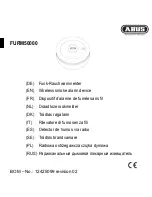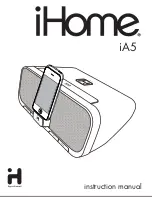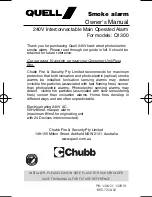
5
INST APD0191 C081230
OPERATIONAL TESTING
To determine the correct operation of the SM-501 Series duct smoke
detector, ensure input power is connected and the green pilot LED is
illuminated.
The LED on the detector head of both the ionization and photoelectric
models (55000-225APO or 55000-328APO) will flash while the unit is in
standby mode. The LED on the detector head of both the ionization and
photoelectric models (55000-250APO or 55000-350APO) will not flash
while the unit is in the standby mode. The LED on all the above detec-
tor heads will be permanently illuminated when smoke is detected and
the head is in alarm.
With the air handling unit shut down (not connected), and the clear
cover removed, press and hold the test/reset button on the SM-501.
The red alarm LED on the circuit board will be illuminated and the alarm
relay outputs will change state. Using a multimeter set to OHMS (or
continuity buzzer function on the meter) place the meter probes on the
following terminals, and ensure the contacts are closed (continuity) (8-
9) and (11-12). When releasing the test/reset button these contacts will
open.
The trouble contacts 13, 14, 15 on the SM-501 detector will not
change state in the event of a fire alarm, operational, or functional
testing. The trouble contacts can be tested by rotating the smoke
detector head counter-clockwise and removing the detector head.
This action will extinguish the green pilot LED and cause the trouble
contacts to change state, (13-14) will be closed (continuity) and (14-
15) will be open circuit. Replacing the detector head and rotating it
clockwise until it locks, will cause the green pilot LED to be illuminat-
ed and the unit will be operational, terminals (13-14) will be an open
circuit and (14-15) will be closed (continuity).
FUNCTIONAL TESTING
Once operational testing is concluded the unit requires functional testing
to determine the correct operation of the detector head.
With the clear cover removed, air handling unit shut down, and using the
Air Products and Controls aerosol test smoke gas part number TG-1000,
spray the test gas directly at the detector head from a distance of 12 inch-
es for 2 seconds.
*
CAUTION: SPRAYING FROM A DISTANCE CLOSER THAN 12
INCHES MAY CAUSE DETECTOR CONTAMINATION.
After 15 to 20 seconds the detector head will go into alarm, illuminating
the detector head LED and causing the duct unit functions to operate,
alarm relays will change state, and the alarm related remote acces-
sories, if attached, will function.
TESTING PROCEDURES
If no test gas is available to conduct functional testing, light a piece of
clothesline (rope) and blow the flame out, hold the smoldering rope 3”
from the detector head and lightly blow across the smoldering area
towards the detector head, the alarm indicator should illuminate within
one minute.
Should additional testing also be required for simulated fire conditions,
smoke bombs placed in the duct may not be suited for the particular
detector head (photoelectric or ionization) selected and installed.
Consult the smoke bomb data for proper use and compatibility with
detector type.
S65A ionization detector head 55000-225APO and S60A ionization
detector head 55000-250APO utilize a radioactive source as its means
of detection and will detect smoke particles of between .1 and 1 micron
in size.
S65A photoelectric detector head 55000-328APO and S60A photoelec-
tric detector head 55000-350APO operate on the principle of light scat-
ter and will detect smoke particles of between 1 and 10 microns in size.
When purchasing smoke bombs for additional required functional testing,
ensure smoke particle sizes comply with the criteria as described above.
MAINTENANCE
Each installation location must be assessed on its own merits. If
the protected area is of a very dirty nature then the SM-501 Duct
unit(s) will have to be checked and cleaned on a quarterly basis or
when cleaning is required.
As a guideline the smoke detector head should be cleaned every six
months or as required. The best methods of cleaning are to vaccum
the detector head thoroughly or to blow the detector head out using
clean, dry compressed air.
Do not use chemicals or non-conforming air to clean the detector
head housing as this could contaminate the detector head and
damage the casing.
Sensing tubes must be inspected and cleaned in accordance with
the schedule as determined above, to allow the free flow of air
through both inlet and exhaust tubes.
Consult your local code and AHJ requirements for required
maintenance schedules.
Above: The LED will be permanently illuminated when the unit is in alarm.
Above: For factory recommended functional testing, spray the proper test
gas directly at the detector head from a distance of 12 inches for 2 seconds.
























